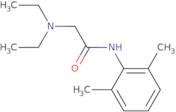
Lidocaine
CAS: 137-58-6
Ref. 3D-FL29061
| 1kg | 640,00 € | ||
| 5kg | 1.582,00 € | ||
| 10kg | 2.054,00 € | ||
| 250g | 299,00 € | ||
| 500g | 450,00 € |
Información del producto
- XylocaineLignocaine2-Diethylamino-N-(2,6-dimethylphenyl)acetamide
- 2',6'-Acetoxylidide, 2-(diethylamino)-
- 2-(Diethylamino)-2',6'-acetoxylidide
- 2-(Diethylamino)-N-(2,6-dimethylphenyl)acetamide
- 2-Diethylamino-2,6'-acetoxylidide
- 2′,6′-Acetoxylidide, 2-(diethylamino)-
- Anbesol
- Anestacon
- Aritmal
- Cuivasil
- Ver más sinónimos
- Dalcaine
- Duncaine
- ELA-Max
- Esracaine
- Isicaina
- Isicaine
- Jetocaine
- LMX
- Leostesin
- Lida-Mantle
- LidoPosterine
- Lidocadren
- Lidocain
- Lidocaina
- Lidoderm
- Lignocaine
- Linisol
- Maricaine
- Medicaine
- Nsc 40030
- Penles
- Remicaine
- Rucaina
- Solarcaine
- Solcain
- Trachisan
- Versatis
- Xilina
- Xybrex
- Xycaine
- Xylestesin
- Xyline
- Xylocain
- Xylocaine
- Xylocitin
- Xylovet
- α-Diethylamino-2,6-acetoxylidide
- Lidocaine base
- 2-diethylaminoacet-2,6-xylidide
- Acetamide, 2-(diethylamino)-N-(2,6-dimethylphenyl)-
- N-(2,6-dimethylphenyl)-N~2~,N~2~-diethylglycinamide
- 2-[(2,6-dimethylphenyl)amino]-N,N-diethyl-2-oxoethanaminium
Please enquire for more information about Lidocaine including the price, delivery time and more detailed product information at the technical inquiry form on this page
Propiedades químicas
Consulta técnica sobre: 3D-FL29061 Lidocaine
Si desea solicitar un presupuesto o realizar un pedido, por favor añada los productos deseados a su carrito y solicite un presupuesto o pedido desde el carrito. Es más rápido, más barato, y podrá beneficiarse de los descuentos y las ventajas disponibles.





